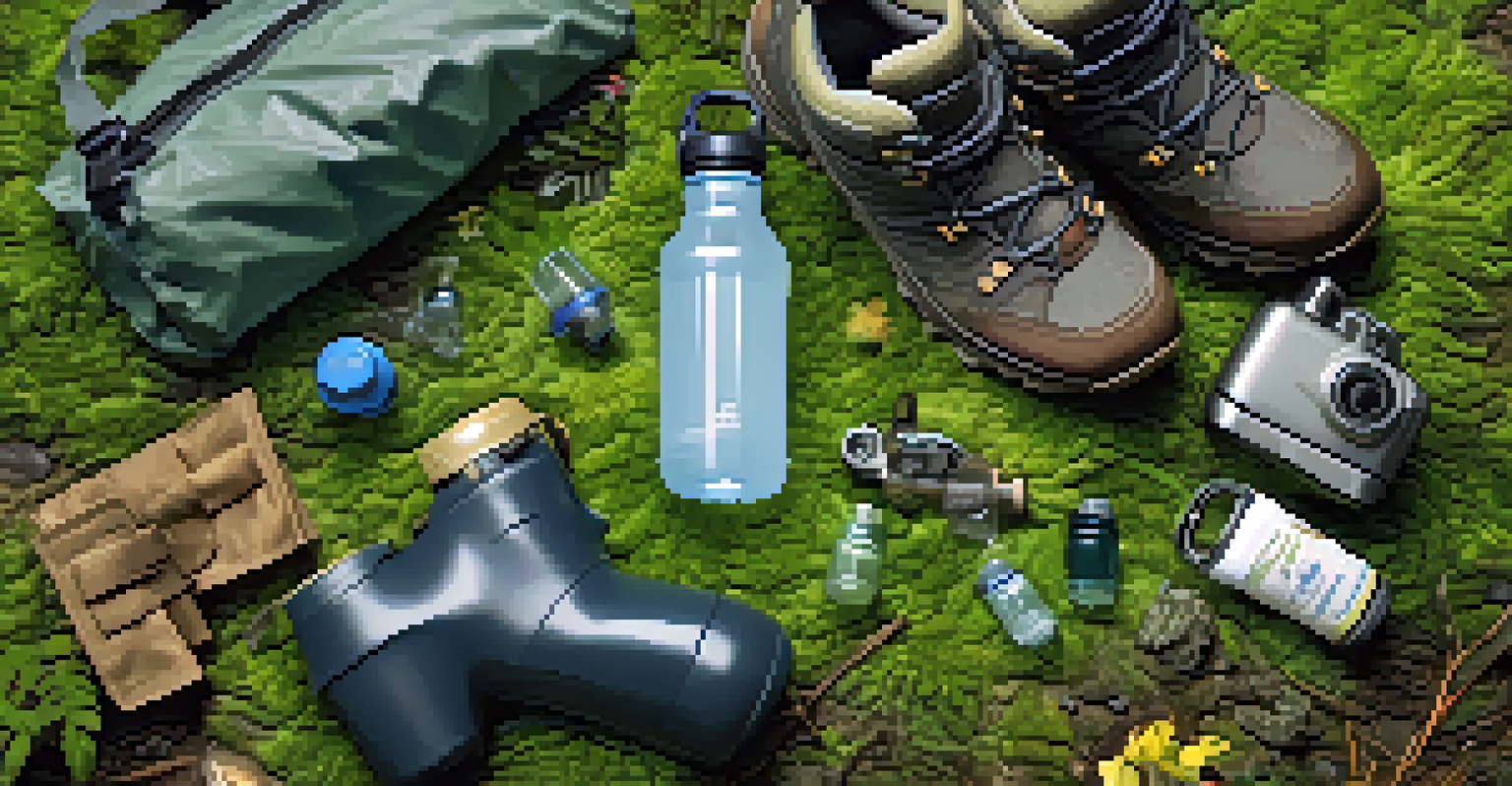Packing for a Tropical Rainforest: What to Include

Understanding the Tropical Rainforest Climate
Before you start packing, it's crucial to understand the climate of a tropical rainforest. These areas are characterized by high humidity and frequent rainfall, which means you need to be prepared for wet conditions. The temperature can be warm during the day but may drop slightly at night, so layers are essential.
In every walk with nature one receives far more than he seeks.
Consider the time of year and the specific rainforest you plan to visit, as this can affect rainfall patterns. For instance, some rainforests have a wet season with daily downpours, while others may experience lighter rain throughout the year. Knowing this can help you choose the right gear to stay comfortable.
Ultimately, being aware of the environment will guide your packing choices, allowing you to enjoy the lush beauty of the rainforest without discomfort. A well-thought-out packing strategy will enhance your experience and keep you focused on the adventure ahead.
Choosing the Right Clothing for the Rainforest
When it comes to clothing, breathability and quick-drying fabrics are your best friends. Lightweight, moisture-wicking shirts and pants can keep you comfortable even when the humidity is high. Look for clothing made from synthetic materials or merino wool, as these dry faster than cotton.

Don't forget to pack a waterproof jacket or poncho! Rain is a frequent visitor in the rainforest, and being caught without proper rain gear can dampen your spirits. A jacket with ventilation will keep you cool while protecting you from the elements.
Prepare for Humid Rainforest Climate
Understanding the tropical rainforest climate is essential for effective packing and ensuring a comfortable experience.
Additionally, consider packing a wide-brimmed hat and UV-protective sunglasses. Not only do they shield you from the sun, but they also add a layer of protection from potential insect bites. Comfort and practicality go hand in hand when choosing your rainforest wardrobe.
Footwear: The Foundation of Your Rainforest Experience
Your choice of footwear can make or break your rainforest adventure. Opt for sturdy, waterproof hiking boots or shoes with good traction to navigate muddy trails easily. Remember, the rainforest can be slippery due to wet conditions, so having the right grip is crucial.
The greatest danger in times of turbulence is not the turbulence; it is to act with yesterday's logic.
Consider bringing a pair of lightweight sandals or water shoes for moments when you need to cool off or relax during your trip. These can be handy when wading through streams or resting at your campsite. Just make sure they're suitable for outdoor use and provide adequate support.
Lastly, don't forget to break in your shoes before the trip! Blisters can ruin any adventure, so ensure your boots are comfortable and ready for those long treks through the vibrant greenery of the rainforest.
Essential Accessories for Rainforest Exploration
Accessories can significantly enhance your experience in the rainforest. Start with a reliable daypack that can hold all your essentials, such as water, snacks, and a first-aid kit. A pack with waterproof compartments can be a game-changer when the rain starts pouring.
Another must-have accessory is a reusable water bottle. Staying hydrated is vital, especially in humid climates. A bottle with a built-in filter can make it easier to drink from natural water sources, ensuring you stay refreshed without carrying excessive weight.
Choose Functional Rainforest Gear
Opt for breathable, quick-drying clothing and sturdy footwear to enhance comfort and safety during your rainforest adventure.
Lastly, a good pair of binoculars can help you take in the breathtaking wildlife without disturbing their habitat. From colorful birds to elusive monkeys, having binoculars can turn a simple hike into a memorable wildlife-watching experience.
Insect Protection: Shields Against Unwanted Guests
Insects are a part of life in the rainforest, and protecting yourself from bites is essential. Start by packing an effective insect repellent with DEET or natural alternatives like lemon eucalyptus oil. Apply it generously to exposed skin before venturing out.
Long-sleeved shirts and pants can provide an extra layer of protection against bugs. Tucking your pants into your socks can also help prevent insect bites on your lower legs, especially in dense vegetation. This simple trick can save you from discomfort during your trip.
Additionally, consider bringing a mosquito net for sleeping if you're camping or staying in basic accommodations. A net can create a bug-free zone, allowing you to rest peacefully after a day of adventure in the vibrant rainforest.
Navigating the Rainforest: Tools and Gadgets
Having the right tools can make navigating the rainforest easier and more enjoyable. A reliable map or GPS device can help you explore without losing your way in the dense foliage. Make sure to download offline maps in case you lose cell service.
A compact flashlight or headlamp is another essential item. The rainforest can get dark quickly, especially under the thick canopy, so having a light source will help you find your way at night or during cloudy days.
Stay Safe with Health Essentials
Packing a compact first-aid kit and knowing common rainforest health risks can help ensure your trip remains enjoyable and safe.
Lastly, consider packing a multi-tool or knife. This can come in handy for various tasks, from preparing food to making quick repairs. A versatile tool can be a lifesaver when you're deep in nature and need a quick solution.
Health and Safety: First-Aid Essentials
Your health and safety should always be a priority when exploring the rainforest. Start with a compact first-aid kit that includes essentials such as band-aids, antiseptic wipes, and pain relievers. Having these items on hand can help you tackle minor injuries without a hassle.
Don't forget to include any personal medications you may need, such as allergy pills or prescription medications. It's also wise to have a small supply of antihistamines, just in case you encounter unexpected allergens while exploring.

Familiarize yourself with the signs of common rainforest illnesses, like heat exhaustion or dehydration. Knowing what to look out for can help you stay alert and take action promptly, ensuring your adventure remains enjoyable and safe.
Final Tips for a Successful Rainforest Trip
As you finalize your packing list, remember to keep your gear organized and easily accessible. Packing cubes or zip-lock bags can help separate items, making it easier to find what you need when you need it. This organization can save you time and frustration during your adventures.
Before you leave, make sure to check the weather forecast for your destination. Being prepared for unexpected weather changes can help you adjust your packing and ensure you're ready for any situation that arises.
Lastly, keep an open mind and a spirit of adventure! The rainforest is full of surprises, and embracing the unexpected can lead to some of the most memorable experiences. With the right gear and attitude, your trip into the tropical rainforest will be a remarkable journey.